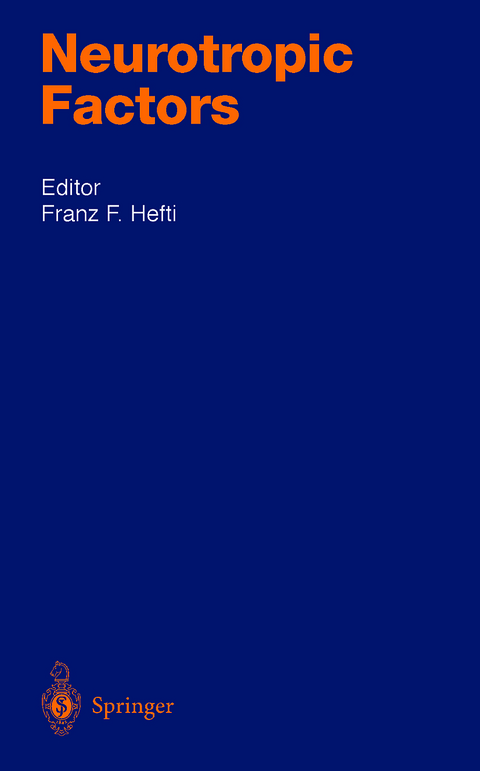
Neurotrophic Factors
Springer Berlin (Verlag)
978-3-642-64182-4 (ISBN)
The pharmacology of neurotrophic factors is part of the general field called neuroprotection or neurodegeneration, which has emerged during the past two decades. This new broad research area has identified molecular mechanisms that regulate the morphological plasticity of the nervous system and, in con sequence, discovered novel pharmacological approaches to manipulate these processes in disease states. The new, structural neuropharmacology as de scribed in this volume attempts to regulate the anatomic aspects of the nervous system and is perhaps comparable to hardware manipulation in computer systems. In contrast, classical neuropharmacology identified multiple ways to modify the function of existing synapses or ion channels in the nervous system, comparable to software manipulations in the computer field. The pharmacol ogy of neurotrophic factor is at an early stage and has not produced any major drugs yet. However, the first quintessential clinical trials have been carried out in the past two years or are currently in progress. Rapid further advances can be expected. The discovery of nerve growth factor (NGF), the first protein known to promote survival and growth of nerve cells, led to the discovery of a family of related proteins, the neurotrophins and their receptors. This concept was generalized to incorporate many other protein families that are included in the functional definition of neurotrophic factors, i. e. , proteins able to regulate survival and differentiation of neurons.
1 Biological Roles of Neurotrophins.- A. Introduction.- B. Neurotrophins in Different Species.- C. Trophic Roles of Neurotrophins in the Peripheral Nervous System.- D. Trophic Roles of Neurotrophins in the Central Nervous System.- E. Synaptic Transmission.- F. Modulation of Transcription of Neurotrophin Genes.- G. Regressive Events and Neurotrophins.- H. Conclusions and Perspectives.- References.- 2 Molecular Anatomy of Neurotrophic Factors.- A. Multi-Component Receptors, Specificity and Cross-Talk.- B. Insights into Neurotrophic-Factor Function from Structural Analyses.- C. Electrostatic Forces and the Interaction of Neurotrophic Factors with Their Receptors.- D. Site-Directed Mutagenesis and Structure-Activity Relationships.- E. Ligands with Altered Receptor-Binding Specificity Offer New Insights into Neurotrophic Factor Function.- F. Conclusions.- References.- 3 Neurotrophin Treatment of Peripheral Sensory Neuropathies.- Abbreviations.- A. Introduction.- B. Organization of the Peripheral Nervous System.- C. Role of NGF in PNS Development.- D. Role of NGF in the Adult PNS.- E. NGF Receptors.- F. The Role of Neurotrophins in the Pathogenesis of Peripheral Sensory Neuropathies.- G. Clinical Peripheral Sensory Neuropathies: Diabetic Polyneuropathy.- H. Trial Design Considerations for the Study of Peripheral Sensory Neuropathies.- I. Clinical Studies of Nerve Growth Factor.- J. Interpretation of Clinical-Trial Results.- K. Conclusions.- References.- 4 Neurotrophic Factors and Amyotrophic Lateral Sclerosis.- A. Introduction.- References.- 5 Neuropharmacology of Insulin-Like Growth Factors.- Abbreviations.- A. Introduction.- B. Background.- C. Neurotrophic Relationships.- D. Neurological Disorders Targeted for IGF Therapy.- E. Pharmacological Considerations.- F. ConcludingComments.- References.- 6 Neurotrophic Factors in Peripheral Nerve Injury and Regeneration.- A. Introduction.- B. Causes of Peripheral Nerve Damage.- C. Symptoms and Pathophysiology of Peripheral-Nerve Damage.- D. Current Approaches to Therapy.- E. Methods for the Study of Peripheral Nerve Damage in Laboratory Animals.- F. Endpoints Used to Assess Peripheral Nerve Regeneration In Vivo.- G. Beneficial Effects of Neurotrophic Agents in Animal Models of Neuropathy.- H. Drug-Development Issues.- I. Clinical Experience with Neurotrophic Factors.- J. Conclusions and Future Directions.- References.- 7 Nerve Growth Factor Treatment for Alzheimer's Disease: The Experience of the First Attempt at Intracerebral Neurotrophic Factor Therapy.- A. Introduction.- B. Nerve Growth Factor as a Therapeutic Agent to Counteract Cholinergic Neuron Degeneration.- C. Neurotrophic Factors for Non-Cholinergic Neurons Affected by the Disease.- D. Relationship to Alzheimer's Disease Pathology.- E. Conclusions.- References.- 8 Neurotrophic Roles of GDNF and Related Factors.- A. Introduction.- B. Molecular Structure of GDNF and Related Molecules.- C. Receptors and Signal Transduction of GDNF and Neurturin.- D. Distribution of GDNF, Neurturin and Their Receptors.- E. Functions of GNDF and Neurturin in the Nervous System As Revealed In Vitro and In Vivo.- F. Developmental Roles of GDNF, Neurturin and Their Receptors As Revealed by Gene Targeting.- G. Perspectives.- References.- 9 Role of Neurotrophic Factors in Cerebral Ischemia.- A. Neurotrophic Factors, Their Receptors and Their Expression in the Central Nervous System (CNS).- B. Hypoxic-Ischemic Injury Regulates the Expression of Neurotrophic Factors and Their Receptors in the Central Nervous System.- C. Specific Growth Factors Can AttenuateMorphological and Functional Damage Caused by Hypoxic-Ischemic Brain Injury.- D. Therapeutic Potential of Neurotrophic Factors in Hypoxic-Ischemic Brain Injury.- References.- 10 Strategies for Administering Neurotrophic Faetors to the Central Nervous System.- Abbreviations.- A. Introduction.- B. Administration of NFs to the Central Nervous System.- C. Delivery Methods.- D. Conclusion.- References.- 11 Neurotrophic Factor Mimetics.- A. Introduction.- B. Direct and Indirect Receptor Ligands.- C. Regulators of Neurotrophic Factor Synthesis or Release.- D. Examples of Growth Hormone Secretagogues.- E. Conclusions.- References.
| Erscheint lt. Verlag | 22.9.2011 |
|---|---|
| Reihe/Serie | Handbook of Experimental Pharmacology |
| Zusatzinfo | XVIII, 325 p. 4 illus. in color. |
| Verlagsort | Berlin |
| Sprache | englisch |
| Maße | 155 x 235 mm |
| Gewicht | 527 g |
| Themenwelt | Medizin / Pharmazie ► Medizinische Fachgebiete ► Neurologie |
| Medizin / Pharmazie ► Medizinische Fachgebiete ► Pharmakologie / Pharmakotherapie | |
| Medizin / Pharmazie ► Pharmazie | |
| Naturwissenschaften ► Biologie ► Humanbiologie | |
| Schlagworte | Alzheimer s disease • Alzheimer´s Disease • anatomy • brain • Brain Injury • Cerebral ischemia • clinical trial • Growth factor • Mutagenesis • nervous system • Neurodegeneration • neurons • Neuropharmacology • Neuropharmakologie • pathophysiology • pharmacology • Physiology • Research • trophic factrosy • trophische Faktoren |
| ISBN-10 | 3-642-64182-2 / 3642641822 |
| ISBN-13 | 978-3-642-64182-4 / 9783642641824 |
| Zustand | Neuware |
| Haben Sie eine Frage zum Produkt? |
aus dem Bereich


